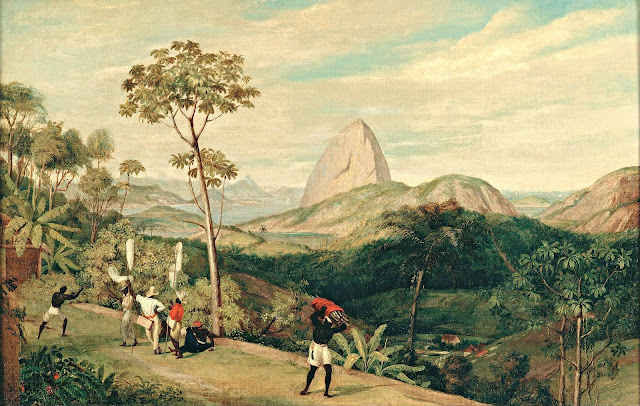Pinacoteca do Estado de São Paulo, Brazil
The painter
Charles Landseer (RA) was an English painter, mostly of historical subjects. He was born the second son of the engraver John Landseer, and the elder brother of the animal painter, Sir Edwin Landseer. He trained under his father, and the painter Benjamin Robert Haydon. He was awarded the silver palette of the Royal Society of Arts for a drawing of Laocoon in 1815, and in 1816 he entered the Royal Academy Schools where he was taught by Henry Fuseli. In 1823 he accompanied Sir Charles Stuart de Rothesay on a diplomatic mission to Portugal and Brazil. Many of the drawings he made on the journey were shown at the British Institution in 1828. He became an associate in of the Royal Academy in 1837, and a full academician in 1845. In 1851, he was appointed Keeper of the Royal Academy, a post requiring him to teach in the "Antique School". He remained in the position until 1873. Most of his pictures were of subjects from British history, or from literature. He paid close attention to the historical accuracy of the accessories and details in his paintings. His works included The Meeting of Charles I. and his Adherents before the Battle of Edgehill, Clarissa Harlowe in the Prison Room of the Sheriff's Office (1833, now in the collection of the Tate Gallery), The Pillaging of a Jew's House in the Reign of Richard I (1839, Tate Gallery) and The Temptation of Andrew Marvel (1841). While under Haydon's instruction he also made a series of detailed anatomical drawings. He died in London on 22 July 1879, leaving quite generously 10,000 guineas to the Royal Academy to fund scholarships.
Sugarloaf Mountain (396 m - 1299 ft), Pao de Açucar in Portuguese, Pain de Sucre in French, is a isolated peak (Inselberg) situated in Rio de Janeiro, Brazil, at the mouth of Guanabara Bay on a peninsula that sticks out into the Atlantic Ocean. Rising above the harbor, its name is said to refer to its resemblance to the traditional shape of concentrated refined loaf sugar. It is known worldwide for its cableway and panoramic views of the city. The name "Sugarloaf" was coined in the 16th century by the Portuguese during the heyday of sugar cane trade in Brazil. According to historian Vieira Fazenda, blocks of sugar were placed in conical molds made of clay to be transported on ships. The shape given by these molds was similar to the peak, hence the name.
Climbing routes:
1907 – The Brazilian engineer Augusto Ferreira Ramos had the idea of linking the hills through a path in the air.
1910 – The same engineer founded the Society of Sugar Loaf and the same year the works were started. The project was commissioned in Germany and built by Brazilian workers. All parts were taken by climbing mountains or lift by steel cables.
1912 – Opening of the tram. First lift of Brazil. The first cable cars were made of coated wood and were used for 60 years.
1972 – The current template trolley was put into operation. This increased the carrying capacity by almost ten times.
2009 – Inauguration of the next generation of cable cars that had already been purchased and are on display at the base of Red Beach.
Visitors can watch rock climbers on Sugarloaf and the other two mountains in the area: Morro da Babilônia (Babylon Mountain), and Morro da Urca (Urca's Mountain). Together, they form one of the largest urban climbing areas in the world, with more than 270 routes, between 1 and 10 pitches long.



